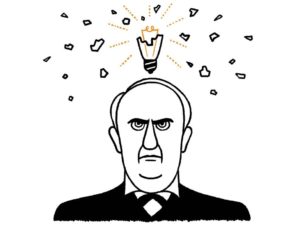8 April 2019 (Brussels, Belgium) – Simon Rich is an American humorist, novelist, and screenwriter. He has published two novels and scores of humor pieces, many of which have appeared in The New Yorker magazine. I met him at The New Yorker Festival which is an annual event organized by the magazine, held in venues in and around New York City in early October. It brings together “a who’s-who” of the arts, politics … and everything in between. The Festival was first held in 1999 and has become a major draw for cultural icons and advertisers alike. I first attended in 2004 and they had 8 presenters in one day. It has grown to a 3-day event with 90+ presenters.
In light of the release today of the UK government’s “Online Harms White Paper” (an attempt to write a “code of practice” for tech companies to control the spread of illegal or harmful content on the internet, and to stop the undermining of civil discourse), I thought this piece by Simon (written two years ago) was spot on.
NOTES FROM THE EDISON LABS, 1891
“Sorry to bother,” Jed murmured. “But I think I maybe made another mixup.”
Thomas Edison squinted at the boy. He’d known for some time that Jed was unintelligent. But lately he’d begun to suspect that the boy was an actual medical idiot.
“What is it now?” Edison muttered.
“Did you say to mix in five centilitres?”
“No,” Edison said. “Five millilitres.”
A nearby beaker exploded, showering them both with shards of glass.
“Sorry,” Jed said.
Edison rubbed his throbbing temples. He’d hired the local boy to help with basic lab work, but even the simplest tasks were beyond his capabilities. The boy’s best hope for contributing to science would be to let doctors dissect his head to study the brain of a moron. There was just no other use for him.
Except, perhaps, for one.
“What do I do?” Jed asked.
“Just stand here,” Edison said. “In this spot.”
He roughly positioned the boy in front of his new apparatus, a square contraption made of metal and glass.
“O.K.,” he said. “Action!”
“What?” the boy said.
“Do some action,” Edison said. “With your body.”
“What kind?”
“It doesn’t matter,” Edison said impatiently. “Here.” He handed the boy a pair of oblong wooden clubs. “Swing these around.”
Jed took the clubs and flailed them jerkily over his head. It was upsetting to watch, but, of course, it didn’t matter what Jed did. The point was for Edison to showcase his lab’s glorious new invention: the kinetograph. Thanks to its novel high-speed shutter system, the device could produce a living photograph—what Edison liked to call a “motion picture.” The phonograph had brought him fame. The light bulb had brought him riches. But this machine would bring him immortality. This machine, he knew, would change the world forever.
Edison titled his film, somewhat sarcastically, “Newark Athlete.” He expected that people would like it, but when he showed it in his lab the response surpassed his wildest expectations. The reporters he’d invited stood up and cheered, laughing and hollering like children.
Edison snapped his fingers, and Jed ran over to bring him a cigar.
“Any questions?” Edison asked the crowd.
The reporters began to shout.
“It’s him!” one of them cried, pointing at the boy. “The Newark athlete!”
Edison turned to Jed, who was smiling stupidly, surprised by the attention.
“Ah, yes,” Edison chuckled. “That’s the boy I used to display my invention. Anyway . . . questions?”
A reporter raised his hand. “Is it O.K. if I ask the boy a question?”
Edison was baffled, but saw no harm in indulging the odd request.
“I suppose that’s fine,” he said.
The reporter turned to Jed and blushed. He looked a bit nervous. “Wow,” he said. “This is exciting. First of all, I just want to say I love your movie.”
Edison choked a little on his cigar. It wasn’t Jed’s movie – it was his. He watched with mounting annoyance as the reporter continued to ramble.
“I think something we’d all like to know is: what kind of preparation did you have to do for your role?”
The boy shrugged. “Not much,” he said. “I sort of just stood in front of the lens.”
The reporter nodded. “So you just, like, channelled it. You were, like, ‘I’m going to be this Newark athlete’ and then you were.”
The boy shrugged. “I guess.”
“Wow,” the reporter said, shaking his head in awe. “Holy shit.”
“O.K.,” Edison said curtly. “That was fun. Any questions for me? The inventor of the kinetograph?”
“Jed!” a reporter in the back shouted. “Do you have any advice for people starting out who want to be in pictures?”
Jed shrugged. “I don’t know.”
“Please!” the reporter begged.
Jed scratched his head. “I guess . . . follow your dreams?”
The crowd applauded.
Edison tried to regain the reporters’ attention, but it was too late. They had rushed past him and were surrounding the boy, peppering him with questions about his personal life.
“No, I’m not seeing anyone right now,” Edison heard Jed say.
“Not seeing anyone, like, at all?” a reporter asked. “Or, like, not seriously dating anyone?”
Jed shrugged. “I guess, like, not seriously dating.”
“So you, like, hook up and stuff.”
Jed nodded. “I hook up.”
Edison realized with amazement that he had been pushed out of his own laboratory. Reporters wrestled past him, brandishing cameras and blasting flash powder in his face. Edison coughed as his throat filled up with magnesium smoke. And, as he sank to his knees, it occurred to him that his prediction had come true: this time, he’d changed the world … forever.
Simon’s inspiration of this piece?
He had stumbled upon Edison’s original Kinetograph experiment:
